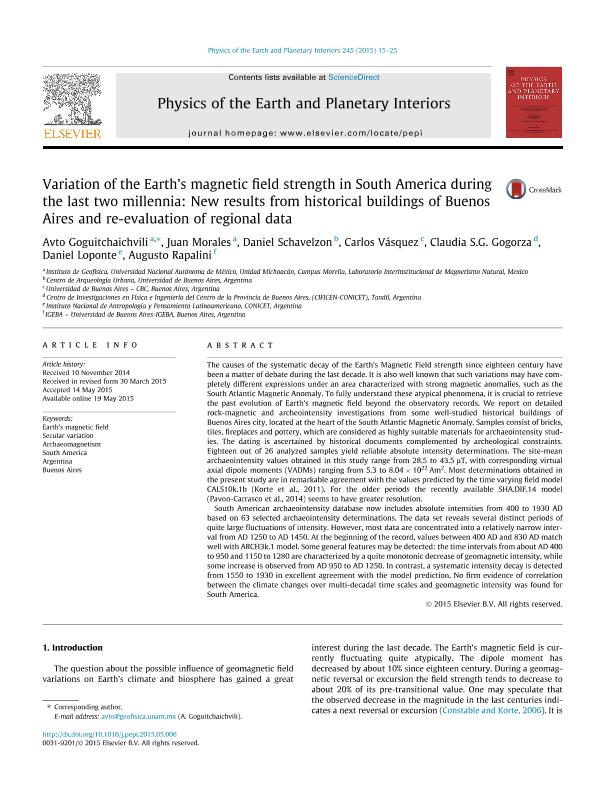Mostrar el registro sencillo del ítem
dc.contributor.author
Goguitchaichvili, Avto
dc.contributor.author
Morales, Juan
dc.contributor.author
Schavelzon Chavin, Daniel Gaston

dc.contributor.author
Vasquez, Carlos Alberto

dc.contributor.author
Gogorza, Claudia Susana

dc.contributor.author
Loponte, Daniel Marcelo

dc.contributor.author
Augusto Rapalini
dc.date.available
2016-04-18T21:12:20Z
dc.date.issued
2015-09
dc.identifier.citation
Goguitchaichvili, Avto; Morales, Juan; Schavelzon Chavin, Daniel Gaston; Vasquez, Carlos Alberto; Gogorza, Claudia Susana; et al.; Variation of the Earth's Magnetic Field Strength in South America During the Last Two Millennia: New results from Historical Buildings of Buenos Aires and Re-evaluation of Regional Data; Elsevier; Physics of the Earth and Planetary Interiors; 245; 9-2015; 15-25
dc.identifier.issn
0031-9201
dc.identifier.uri
http://hdl.handle.net/11336/5281
dc.description.abstract
The causes of systematic decay of the Earth´s Magnetic Field strength since eighteen century have been a matter of debate during the last decade. It is also well known that such variations may have completely different expressions under an area characterized with strong magnetic anomalies, such as the South Atlantic Magnetic Anomaly. To fully understand these atypical phenomena, it is crucial to retrieve the past evolution of Earth´s magnetic field beyond the observatory records. We report a detailed rock-magnetic and archeointensity investigations from some well-studied historical buildings of Buenos Aires city, located in the hearth of the South Atlantic Magnetic Anomaly. Samples consist of bricks, tiles, fireplaces and pottery which are considered as highly suitable materials for archaeointensity studies. The dating is ascertained by historical documents complemented by archeological constraints. Eighteen out of 26 analyzed samples yield reliable absolute intensity determinations. The site-mean archaeointensity values obtained in this study range from 28.5 to 43.5 µT, with corresponding virtual axial dipole moments (VADMs) ranging from 5.3 to 8.04 1022 Am2. Most determinations obtained in the present study show remarkable agreement with the values predicted by the time varying field model CALS10k.1b [Korte et al. 2011]. South American archaeointensity database now includes absolute intensities from 400 to 1930 AD based on 63 selected archaeointensity determinations. The data set shows several distinct periods of quite large fluctuations of intensity. However, most data are concentrated into a relatively narrow interval from ad 1250 to ad 1450. At the beginning of the record, values between 400 AD and 830 AD match well with ARCH3K model. Some general features may be detected: the time intervals from about AD 400 to 950 and 1150 to 1280 are characterized by a quite monotonic decrease of geomagnetic intensity, while some increase is observed from AD 950 to 1250. In contrast, a systematic intensity decay is detected from 1550 to 1930 in excellent agreement with the model data. No firm evidence of correlation between the climate changes over multi-decadal time scales and geomagnetic intensity was found for South America.
dc.format
application/pdf
dc.language.iso
eng
dc.publisher
Elsevier

dc.rights
info:eu-repo/semantics/openAccess
dc.rights.uri
https://creativecommons.org/licenses/by-nc-nd/2.5/ar/
dc.subject
Earth´S Magnetic Field
dc.subject
Secular Variation
dc.subject
Archeomagnetism
dc.subject
South America
dc.subject
Argentina
dc.subject
Buenos Aires
dc.subject.classification
Geociencias multidisciplinaria

dc.subject.classification
Ciencias de la Tierra y relacionadas con el Medio Ambiente

dc.subject.classification
CIENCIAS NATURALES Y EXACTAS

dc.title
Variation of the Earth's Magnetic Field Strength in South America During the Last Two Millennia: New results from Historical Buildings of Buenos Aires and Re-evaluation of Regional Data
dc.type
info:eu-repo/semantics/article
dc.type
info:ar-repo/semantics/artículo
dc.type
info:eu-repo/semantics/publishedVersion
dc.date.updated
2016-05-06 15:52:43.262787-03
dc.journal.volume
245
dc.journal.pagination
15-25
dc.journal.pais
Países Bajos

dc.journal.ciudad
Amsterdam
dc.description.fil
Fil: Goguitchaichvili, Avto. Universidad Nacional Autónoma de México; México
dc.description.fil
Fil: Morales, Juan. Universidad Nacional Autónoma de México; México
dc.description.fil
Fil: Schavelzon Chavin, Daniel Gaston. Universidad de Buenos Aires. Facultad de Arquitectura y Urbanismo. Instituto de Arte Americano e Investigaciones Estéticas "Mario J. Buschiazzo". Centro de Arqueologia Urbana; Argentina
dc.description.fil
Fil: Vasquez, Carlos Alberto. Universidad de Buenos Aires. Ciclo Básico Común; Argentina
dc.description.fil
Fil: Gogorza, Claudia Susana. Consejo Nacional de Investigaciones Científicas y Técnicas. Centro Científico Tecnológico Tandil. Centro de Investigaciones en Física e Ingeniería del Centro de la Provincia de Buenos Aires; Argentina
dc.description.fil
Fil: Loponte, Daniel Marcelo. Secretaría de Cultura de la Nación. Dirección Nacional de Cultura y Museos. Instituto Nacional de Antropología y Pensamiento Latinoamericano; Argentina. Consejo Nacional de Investigaciones Científicas y Técnicas; Argentina
dc.description.fil
Fil: Augusto Rapalini. Consejo Nacional de Investigaciones Científicas y Técnicas. Oficina de Coordinación Administrativa Ciudad Universitaria. Instituto de Geociencias Básicas, Aplicadas y Ambientales de Buenos Aires; Argentina
dc.journal.title
Physics of the Earth and Planetary Interiors

dc.relation.alternativeid
info:eu-repo/semantics/altIdentifier/url/http://www.sciencedirect.com/science/article/pii/S0031920115000795
dc.relation.alternativeid
info:eu-repo/semantics/altIdentifier/doi/http://dx.doi.org/10.1016/j.pepi.2015.05.006
Archivos asociados
